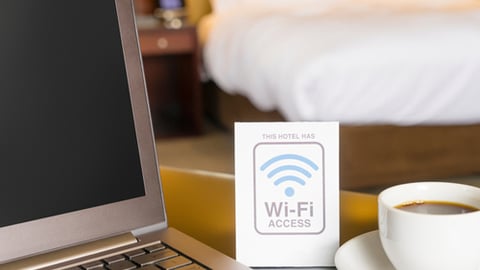Consider These 3 Factors When Choosing a Low- or High-Power DAS
Travelers and event attendees now expect reliable, consistent cellular connectivity from anywhere in a hotel during their vacation, business trip or convention. To facilitate solid in-building wireless connectivity, many hotels, casinos and convention centers are installing a distributed antenna system (DAS), which typically comprises active electronics – usually a central hub connected to remote units – paired with antennas distributed throughout a building, with cabling interconnecting the elements. The central hub is connected to an RF source that supplies the cellular signal.
DAS is attractive to hotels for its high capacity, level of service, and ability to seamlessly hand off calls from the outside network to the inside network as users move from outside to inside the building. However, when choosing a DAS, it’s not always clear what power level a hotel should opt for – because it depends on several factors. This article from Zinwave will help hoteliers understand which factors they should consider when deciding on a power level.
Evaluating Coverage Needs vs. Capacity Needs:
Today, users require faster speed and more capacity. That is why most operators select low power as a primary option for the densification of the network. Low power is the ideal option for faster speed and more capacity, as the RF signal is easier to control, and it brings the user faster speed.
Unlicensed frequency spectrum in 3.5GHz to 4.2GHz will be challenging or even impossible to efficiently support using high-power networks, and RF losses at those frequency bands over coaxial systems will be significant. Future technologies like 5G will require minimum network latency, and coaxial cables used in high-power networks have higher latency than all fiber-optic networks used by low-power systems.
Sectorization:
Each DAS connection point can only handle so many connections. Large or spread-out hotels can “zone” connectivity (similar to zoning HVAC). Guests staying in rooms that straddle one or more zones might ping between two different sectors because the signals overlap. Additionally, a high-rise hotel is more susceptible to wireless interference, so sectorization can help guests’ devices make and stay with the right connection for their floor.
It’s much easier to efficiently scale a low-power system for capacity as coverage needs shift, because each remote covers a much smaller area. With a high-power system, where each remote unit covers a much larger area, you risk having too many people within that zone for a single network sector to support. That means the reliable cellular connectivity you were trying to provide by switching to DAS may not be significantly better than it was before.
Future Needs:
A wideband, low-power system requires few to no upgrades for future frequency bands, technology or operators. High-power systems will require installing a substantial amount of equipment in telco closets, whereas low-power systems will not.
Also consider monitoring costs. In high-power systems, and fiber/coaxial hybrid low-power systems, the passive parts of the system (anything after IDF closets) aren’t monitored. Once troubleshooting is required, field crews have to make educated guesses about where the problem is with the passive distribution – sometimes spending countless hours doing so – while in a properly configured low-power system, monitoring software will identify the exact point of failure within seconds.
There are multiple factors in play when determining which power level to choose – meaning it’s crucial for hospitality professionals to be educated about their options. Examining performance, scalability and future needs will help guide hotels to the right solution – helping them serve their guests well for years to come.


